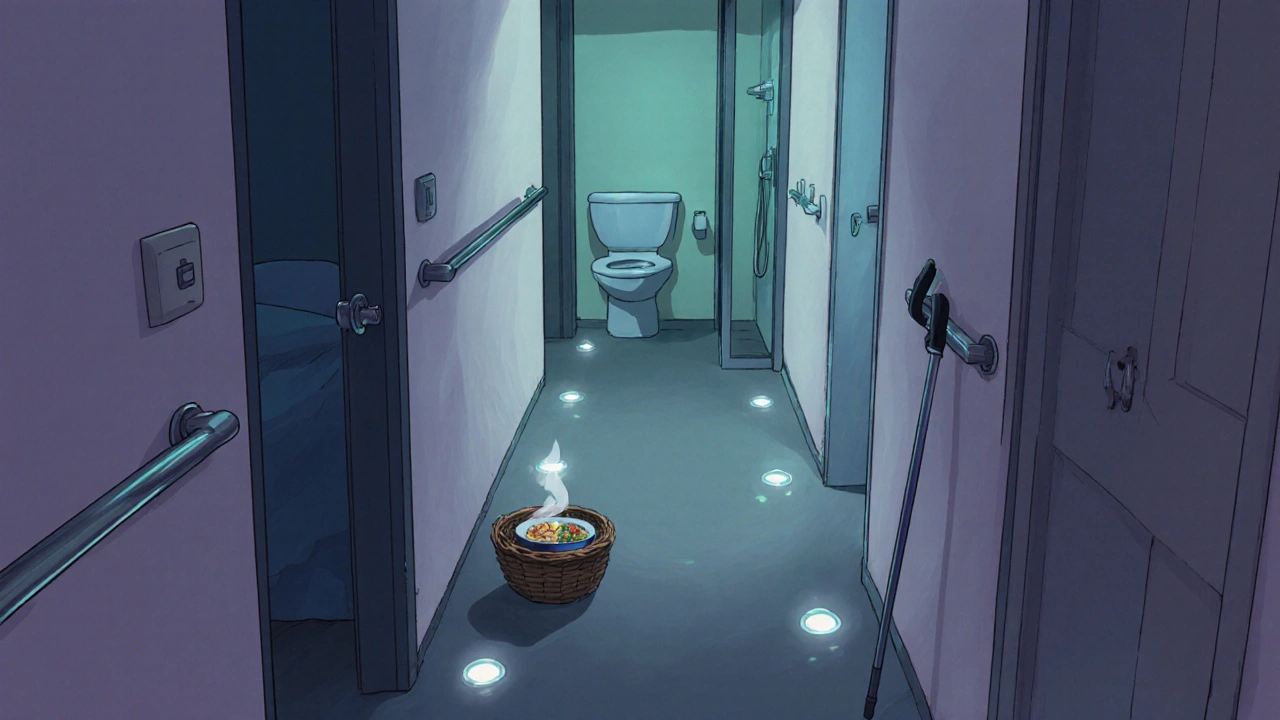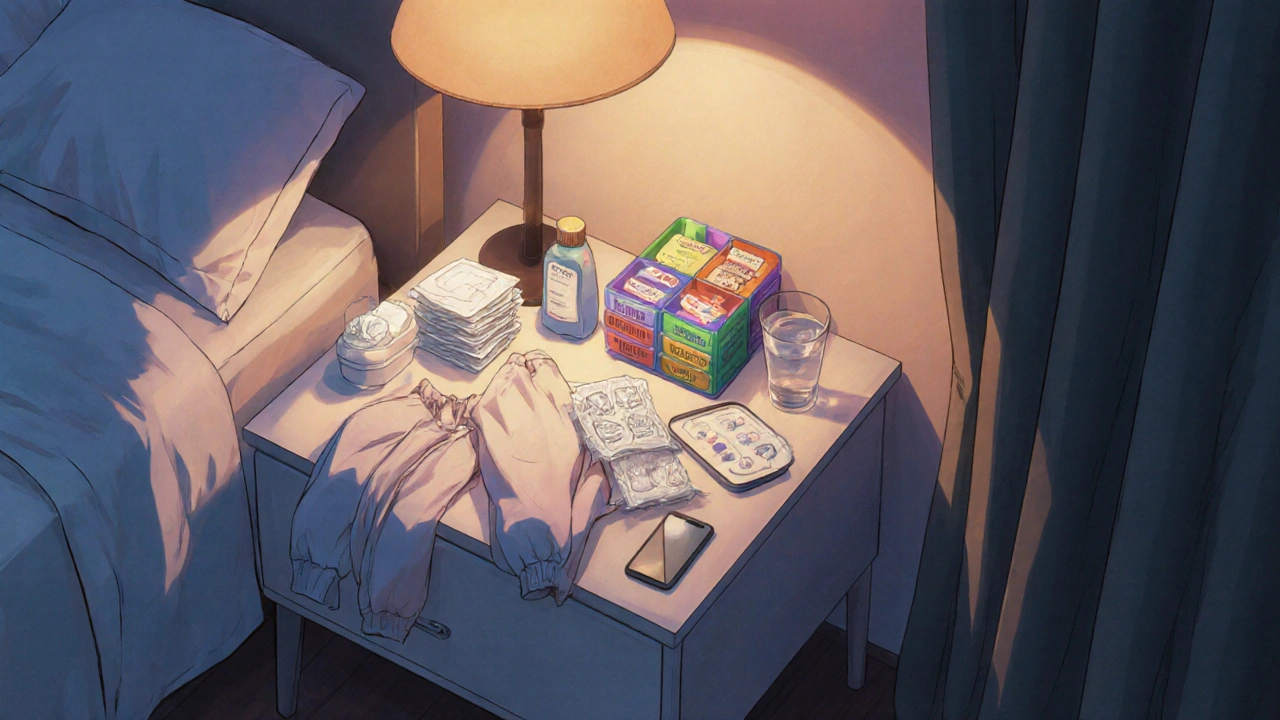Home Recovery Preparation Tool
Recovery Preparedness
When you’re preparing for Home recovery after minor surgery is a period of healing that takes place at home following a low‑risk surgical procedure, the right setup can mean fewer complications and a smoother return to daily life.
Gather Essential Supplies Before You Arrive Home
Start with a supplies list a day or two before discharge. Having everything within arm’s reach means you won’t need to make painful trips to the kitchen or bathroom.
- Soft, breathable clothing that’s easy to slip on (think loose‑fit tees, joggers, and front‑zip pajamas).
- Disposable or washable wound dressings, antiseptic wipes, and any prescribed ointments.
- A sturdy, low‑profile nightstand or bedside table for meds, water, and a phone.
- Reusable ice packs and a small heating pad for swelling control.
- A medication organizer with labeled compartments for each day.
Check with your surgeon’s nurse about any specific items they recommend for your particular procedure.
Make Your Space Safe and Accessible
Safety is the cornerstone of a successful home recovery. Even a short walk to the bathroom can become risky if the path is cluttered.
Fall prevention involves arranging furniture, securing rugs, and installing temporary aids to minimise trips and slips. Follow these steps:
- Clear the route from bedroom to bathroom: remove loose rugs, cords, and shoes.
- Place night‑lights along the hallway and inside the bathroom to improve visibility after dark.
- Install grab bars beside the toilet and in the shower if you anticipate needing extra support.
- Keep a sturdy walking aid (cane, crutches, or rollator) within easy reach.
- Arrange a chair or stool in the kitchen at waist height to sit while preparing food.
These changes don’t have to be permanent; most are simple, inexpensive, and easy to reverse once you’re back on your feet.
Plan Nutritious, Easy‑Prep Meals
Good nutrition fuels tissue repair and keeps energy levels up. The challenge is that cooking can be tiring when you’re still sore.
- Stock up on ready‑to‑eat protein sources: pre‑cooked chicken strips, boiled eggs, cottage cheese, and Greek yoghurt.
- Buy frozen veggies that can be microwaved in minutes; they retain most nutrients and need no chopping.
- Prepare a batch of easy soups or casseroles the night before discharge. Portion them into single‑serve containers for quick heating.
- Keep hydration handy-a large water pitcher on the nightstand encourages frequent sipping.
If you have a friend or family member willing to drop off meals, set up a simple schedule: one hot meal on day 2, another on day 4, and a grocery delivery on day 6.
Organize Medications and Pain Management
Missing a dose can delay healing, while over‑medicating can cause side effects. A structured routine is key.
Medication organizer is a compartmental tray that sorts pills by day and time, reducing confusion and missed doses. Here’s how to set it up:
- Label each compartment with the exact time (e.g., 08:00, 12:00, 18:00).
- Place the organizer on your bedside table, next to a glass of water.
- Write the purpose of each medication on a sticky note and tape it to the organizer for quick reference.
For pain control, follow the surgeon’s prescription schedule. Use the ice pack for the first 24‑48 hours, then switch to a heating pad if stiffness appears. Keep a pain‑tracking chart in a notebook - noting time, intensity (0‑10), and any side effects - to share with your doctor during follow‑up.

Set Up Comfort and Rest Zones
Rest is when the body does most of its rebuilding. Create a restful nook that discourages unnecessary movement.
- Place a firm pillow behind your back if you’re lying on your side; this reduces pressure on the incision.
- Use a pillow wedge to elevate your legs, which improves circulation and reduces swelling.
- Keep the TV remote, phone charger, and any entertainment (books, tablet) within arm’s length.
Turn off bright overhead lights in favor of a soft bedside lamp. Dim lighting helps your brain release melatonin, promoting deeper sleep.
Arrange Help and Communication
Don’t try to do everything alone. A small support network can catch problems early.
- Share your discharge plan with a trusted friend or family member. Ask them to check in via text or call at set times (e.g., 09:00, 14:00, 20:00).
- Set up a telehealth appointment for day 3 or day 5. Many clinicians use video calls to assess incision healing without a clinic visit.
- Keep a list of emergency contacts - surgeon’s office, local pharmacy, and the nearest hospital - on your fridge.
Having designated people to run errands or prepare meals eliminates the temptation to over‑exert yourself.
Simple Physical Activity and Therapy Tips
Even minor surgery benefits from gentle movement. It prevents stiffness, supports circulation, and accelerates return to function.
- Start with ankle pumps and toe curls every hour while seated - these promote blood flow in the lower limbs.
- Progress to short hallway walks (5‑10 minutes) twice a day, using your walking aid if needed.
- If your surgeon approved, perform basic shoulder rolls or neck stretches to keep upper‑body tension low.
Document each activity in a recovery log. Note pain level before and after; if you notice a spike, pause and inform your healthcare provider.

Checklist for a Smooth Recovery
- Supplies ready: clothing, dressings, ice/heat, medication organizer.
- Safety audit completed: pathways cleared, grab bars installed, night‑lights placed.
- Meal plan set: protein sources stocked, microwavable veggies, pre‑made soups.
- Medication schedule organized and pain‑tracking chart printed.
- Comfort zone arranged: pillows, lighting, entertainment within reach.
- Support network briefed and telehealth appointment booked.
- Gentle activity routine drafted and logged.
Cross each item off as you complete it - the visual progress boost can be surprisingly motivating.
Comparison of Common Assistive Devices
| Device | Ideal For | Weight Capacity | Pros | Cons |
|---|---|---|---|---|
| Cane | Upper‑body injuries, short‑term use | Up to 250 lb (113 kg) | Light, inexpensive, easy to store | Limited support on uneven surfaces |
| Crutches | Lower‑leg or foot surgery | Up to 300 lb (136 kg) | Excellent weight‑bearing support | Can strain arms, harder to navigate indoors |
| Rollator | Balance issues, longer recovery periods | Up to 350 lb (159 kg) | Four‑point stability, built‑in seat, storage basket | Bulkier, higher cost |
Pick the device that matches your mobility level and home layout. For most minor‑surgery patients, a simple cane works well, but if you anticipate swelling in the lower leg, crutches provide the extra support needed.
Final Thoughts
Preparing your home before you step through the hospital doors can shave days off your recovery timeline and keep complications at bay. By tackling supplies, safety, nutrition, medication, comfort, support, and gentle activity, you give your body the best chance to heal quickly.
Remember, home recovery after minor surgery isn’t a solo endeavor - lean on loved ones, use the tools at hand, and keep the lines of communication open with your medical team.
How long should I wait before walking unaided?
Most surgeons advise waiting 48‑72 hours before attempting unaided walks. Start with short, supervised steps and increase distance only if pain remains low and the incision looks clean.
Can I use a heating pad on the incision site?
Apply heat only after the first 24‑48 hours and never directly on the wound. Wrap the pad in a thin towel and limit each session to 15‑20 minutes to avoid excess swelling.
What foods should I avoid during recovery?
Steer clear of heavy, fried, or highly processed meals that can cause inflammation. Limit sugar‑rich desserts and alcohol, as they may impair wound healing.
How often should I change my wound dressing?
Follow your surgeon’s instructions, but a common rule is every 24 hours or sooner if the dressing becomes damp or dirty. Always wash hands before and after handling the wound.
Is telehealth reliable for post‑op check‑ins?
Yes. Video calls let doctors visualise the incision, ask about pain levels, and adjust medication without you needing to travel. Ensure you have a stable internet connection and good lighting for clear visuals.

